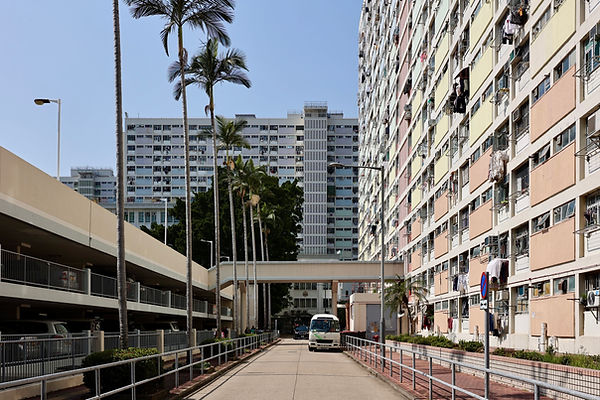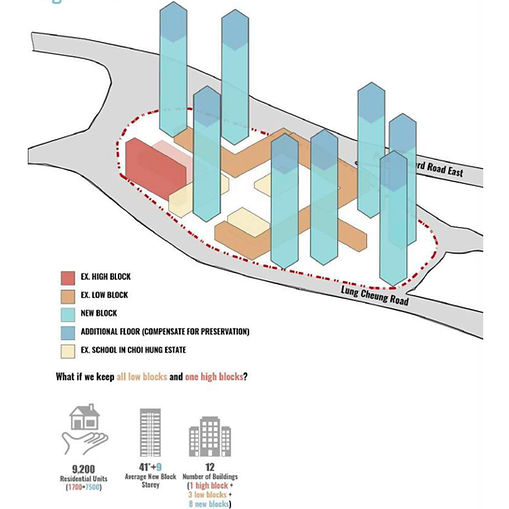STORY
The finest Modernist Public Housing in Hong Kong
When Choi Hung Estate was completed in 1962, it was the world’s tallest in storey and densest: eight 20-storey blocks, 7,450 units, housing 43,300 people. Choi Hung’s scale was a global breakthrough, with density and community both guaranteed. According to Docomomo Scotland Chapter, Choi Hung Estate emphasises a fully-fledged modernist architectural approach which sets it radically apart from the utilitarian tenements of the ‘Resettlement’ tradition. Two heights of slab blocks (Low Block with 7-storey and High block with 20-storey) were strategically positioned to mitigate the visual compression often associated with high-density housing. With Le Corbusier’s modernist principles implemented, public space was filled in every corner, with public amenity of the bank, post office, welfare services, schools provided within the estate. It was a pioneering experiment to plan a housing estate in such density with a focus of cultivating a sense of community.

Source: Kelvin Ng
PRESERVATION
Scenario 2
Integrated Redevelopment - Balanced Redevelopment with Preservation Focus
Core Concept: Enlarge the footprint of Choi Hung Estate's architectural and historical preservation by retaining all low blocks and one high block, while optimising development potential through new construction. This approach fulfill the increased housing units and preserve community nodes, connections.
Pros:
-
Preserve more of the original estate's architecture and layout
-
Preserves a mix of building types, better representing the estate's history
-
Allows for some modernisation while keeping significant heritage elements
Cons:
-
More complex redevelopment process
-
May limit options for optimising land use
-
Potential challenges in integrating preserved and new structures
_Page.jpg)
IDEA
POOL
_edited_edited_edited_edited.png)
‘’ Keeping a Place through Inviting Everyone In ‘’
Co-founder and Design Director, One Bite; Certified Professional Facilitator, IAF
Sarah Mui
Based on your experience in public engagement across various communities, what observations have you made about residents who show a strong sense of belonging?
In the context of redevelopment, what key information should we gather from residents during engagement?
In Choi Hung Estate, the road names are made by the residents themselves. What are some ways you think residents can actively participate in building a community?
In our experiences of engaging with various communities, the residents who demonstrate the strongest sense of belonging are those who have had memorable personal encounters, have engaged with their surroundings in diverse capacities, and have derived benefits from their environments for both their physical and mental well-being. These diverse capacities range from being informed about and consulted on the status of their surroundings to being able to co-create new ideas and co-design solutions for others. The greater the level of citizen participation, the stronger their positive sense of place will be.
In the context of redevelopment, I believe it is crucial to carefully identify both emotional attachments and physical needs. Embracing residents across a wide age spectrum will aid in building a resilient community network capable of withstanding the lengthy redevelopment process. Imagining the future over the next 10 to 15 years can be distressing for some residents, particularly the elderly. However, connecting them with younger generations can facilitate the sharing of cherished memories of their surroundings and the transmission of the area's history to the youth. This approach will foster a more holistic understanding of the future physical requirements of the place. Engagement presents an excellent opportunity to collaboratively create a better plan, where everyone can visualise their role and have a stake in re-creating memorable spots and developing new social spaces.
Participation can encompass both co-creation and co-design, enabling engagement with diverse types of residents. This starts from the initial stages of redevelopment planning, including the co-design of functions, aesthetics, names, and identity. All these are feasible with a facilitation team comprising both facilitators and designers. On the other hand, co-creation can also take various forms, such as collaborating on future public artworks by collecting objects from the present, and co-creating furniture, signage, and letterboxes for the future space. However, beyond merely producing outputs from engaging residents, it is crucial to consider the outcomes of such engagement. Effective participation, which encourages ongoing involvement, must connect with the local context, demonstrate respect for participants, and create real impact, i.e., tangible enhancements. It is not merely a one-off event to open dialogue with residents, but can be thoughtfully designed as a sustainable solution for place-keeping.

